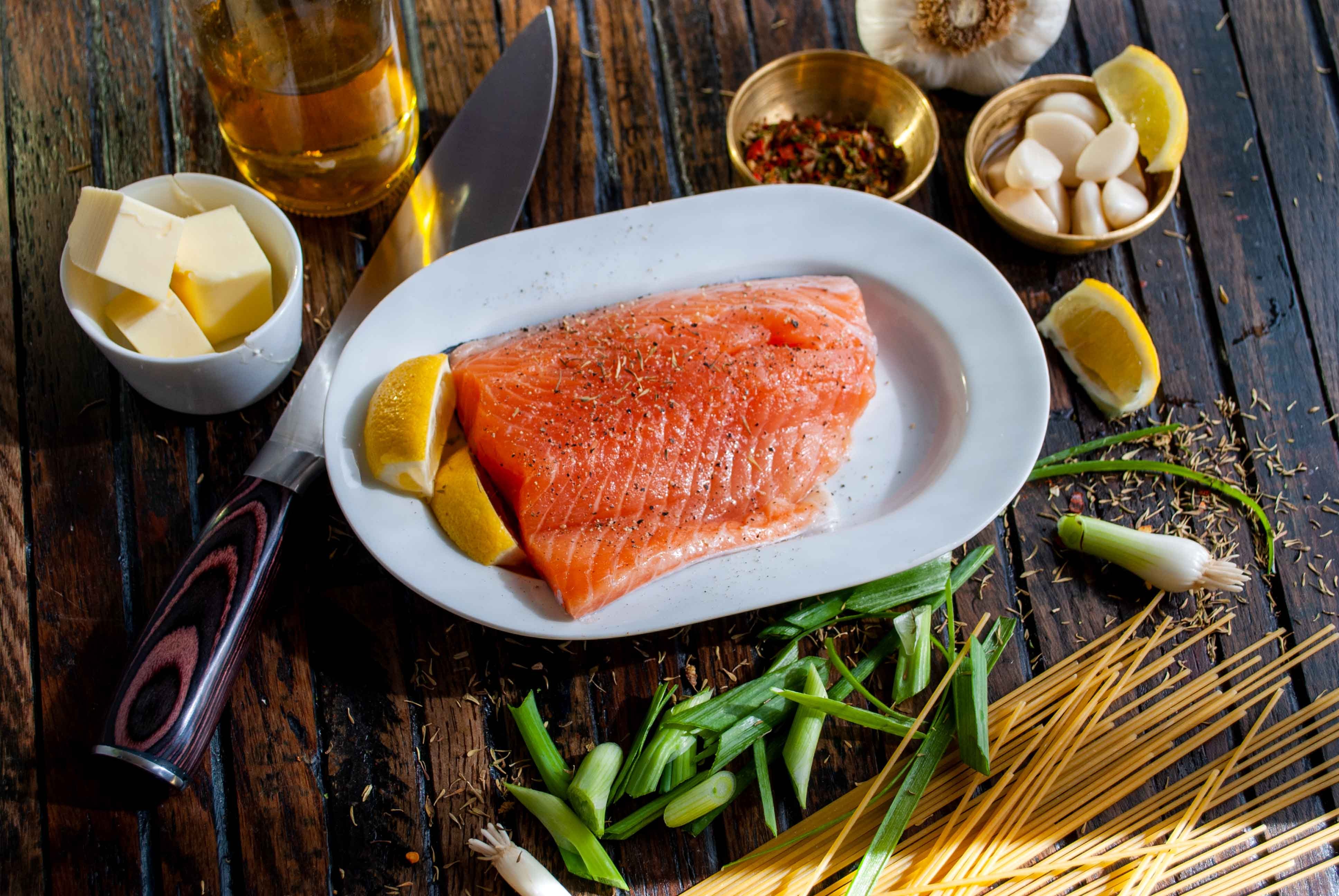What does your breakfast look like? Perhaps it’s something delicious between a toasted bagel? Maybe you avoid all carbohydrates and only eat eggs? Maybe you skip breakfast completely and practice intermittent fasting? However you build your meals, it’s likely that you, like most health-conscious people, have put plenty of thought into them; and why wouldn’t you? With the rise of so many diet plans, there’s something out there for everybody. Yet for some, that’s the problem. The issue isn’t about options, it’s about knowing which one suits you the best.
While this article does not offer medical advice, we explore four of the most common and trendiest diets, along with their benefits and drawbacks. We should be able to give you all of the information you need to get on the right track to eating well. So, whether you’re interested in the potential of keto, the simplicity of paleo, benefits of Mediterranean foods, rawness of the carnivore diet, let’s dig in!
1. The Ketogenic Diet
What is Keto?
In a nutshell, the ketogenic diet is a high-fat, low-carbohydrate diet. It’s also known as the keto diet and is incredibly popular, especially with those who are seeking weight loss. The idea is that when you reduce the number of carbohydrates in your diet, your body will eventually burn fat for fuel. And while this seems like the perfect solution to reduce excess body fat, there are other significant benefits to be found. Before we get into the benefits, let’s understand how the keto diet works.
How does Keto Work?
The body uses glucose for energy which is why carbohydrates typically make up the largest portion of our meals. However, when carbs are significantly reduced, the body goes into a state of ketosis (using fat for fuel).
Fatty acids from the body’s fat stores are transported to the liver where they are turned into ketones (the ‘fat fuel’). What’s interesting about this process is that ketones, unlike fatty acids, can supply the brain with energy in the absence of glucose. But what’s the point of it all?
Benefits of Keto Diet
Weight Loss
As mentioned, this low-carb meal plan is often praised as a great way to lose weight. For example, when excess carbs are consumed in a standard American diet, the sugar they’re broken down into is stored as fat. With a keto diet, the fact that there is a reduction in the fat storage process aids the fat loss process.
On the other hand, a keto diet meal plan can also make you feel more satisfied and therefore eliminates the risk of overeating. Since a large food group is cut out, you can eat as much as you want, which is ideal for people who don’t like to count calories and really seek that satisfaction of being full after a meal. Studies also suggest that this diet can naturally decrease your appetite.
Improved Insulin Sensitivity
Ramping up your blood sugar levels with excessive carbohydrates can lead to insulin resistance. This is something you want to avoid at all costs; a lack of insulin sensitivity can lead to type 2 diabetes and serious damage to the heart, eyes, and nerves.
While the disease is life-threatening, one study shows that when carbohydrate consumption is significantly reduced (on a ketogenic diet), insulin sensitivity improved by a whopping 75% in participants. Another study looks at women with type 2 diabetes and found that after following a low-carb diet for 90 days, hemoglobin AC1 was reduced, meaning long-term blood sugar management improved.
It can therefore be argued that following a keto diet improves insulin sensitivity. This, along with the prospects of weight loss, make it an appealing way to eat, but what about the drawbacks?
The Drawbacks of the Ketogenic Diet
Difficult to Maintain
While a ketogenic diet doesn’t necessarily restrict calories, it is restrictive with what you can and can’t eat. To feel the full effects, your carbohydrate intake has to be extremely low and you would need to sustain yourself mostly on fats and proteins. Since it is commonplace to eat carbs with every meal, a keto diet can be challenging. Especially when you consider social events, special occasions, and those all-too-tempting cravings. Do you have kids? Good luck saying ‘no’ when they are eating things like pizza and donuts!
Potential Nutrient Deficiencies
Similarly, the restriction of certain foods could lead to micronutrient deficiencies. There are plenty of nutrients to be found in fruits, veggies, legumes, and whole grains so there’s no surprise that many people feel lethargic and foggy when on this diet.
Why is Keto so Popular?
A clear reason why the ketogenic diet is so popular comes down to the effects it has on insulin sensitivity. Since 1.5 million deaths are attributed to diabetes every year, this diet offers a potential cure for those with type 2 and for anyone on the verge of developing the disease. Many others lean towards a keto plan for the weight loss benefits too, but given the possible side effects, a health-conscious person who is already fit and healthy may not enjoy this way of eating.
Sample Daily Keto Meal Plan:
Breakfast:
- Three-egg omelette with cheese, spinach, and mushrooms cooked in butter or coconut oil
- Bulletproof coffee made with coffee, MCT oil, and grass-fed butter or coconut oil
- Greek yogurt topped with berries and chopped nuts
Lunch:
- Grilled chicken or beef salad with mixed greens, avocado, and a dressing made with olive oil and apple cider vinegar
- Tuna salad with mixed greens, celery, and mayonnaise
- Zucchini noodles (zoodles) with meatballs and marinara sauce
Dinner:
- Grilled or baked salmon with roasted broccoli and cauliflower, drizzled with olive oil
- Baked chicken thighs with a side of sautéed spinach and mushrooms
- Bunless burger with bacon, cheese, and avocado, served with a side salad dressed with olive oil, balsamic vinegar and lemon juice
Snacks:
- Cheese slices or cubes
- Nuts, such as almonds or macadamia nuts
- Hard or soft-boiled eggs
It’s important to note that the keto diet can be challenging to follow, especially for those who are used to consuming carbs on a regular basis.
High Fat Foods for Keto
High fat foods are an essential component of the ketogenic diet, a popular low-carb, high-fat diet that aims to shift the body into a state of ketosis, where it burns fat for energy instead of carbohydrates. Foods that are high in healthy fats such as avocados, nuts, seeds, and fatty fish like salmon and tuna are excellent choices for those following a keto diet. Other sources of healthy fats include coconut oil, olive oil, and grass-fed butter. Additionally, high-fat dairy products like cheese and heavy cream are also great options for those on a keto diet. However, it’s important to remember to balance high-fat foods with moderate protein and low-carbohydrate options to maintain ketosis and achieve optimal health.
Here’s a List of 10 High-Fat Foods That are Great for the Keto Diet:
- Avocado – Avocados are a rich source of monounsaturated fats, fiber, and various vitamins and minerals.
- Butter – Grass-fed butter is high in saturated fat and is a great source of fat-soluble vitamins.
- Coconut oil – Coconut oil is rich in medium-chain triglycerides (MCTs), which are easily converted to ketones and used as energy.
- Nuts – Nuts such as almonds, macadamias, and pecans are high in healthy fats and low in carbs.
- Seeds – Seeds such as chia, flax, and hemp are rich in healthy fats and fiber.
- Fatty fish – Fatty fish like salmon, sardines, and mackerel are high in omega-3 fatty acids and provide a good source of protein.
- Cheese – Cheese is high in saturated fat and protein, making it a great food choice for the keto diet.
- Heavy cream – Heavy cream is a high-fat dairy product that is low in carbs and can be used in keto-friendly recipes.
- Olive oil – Olive oil is a healthy source of monounsaturated fat and is great for cooking and dressing salads.
- Bacon – Bacon is high in fat and protein and can be a delicious addition to a keto meal.
What is Keto Burn and Does it Work?
Keto Burn is a dietary supplement that has gained popularity among individuals following the ketogenic diet. The supplement contains a blend of natural ingredients that are designed to support ketosis, a metabolic state in which the body burns fat for energy instead of carbohydrates. The primary ingredient in Keto Burn is beta-hydroxybutyrate (BHB), which is a ketone body that can be used by the body for energy during periods of carbohydrate restriction. By supplementing with BHB, Keto Burn can help increase blood ketone levels, which may result in increased energy, improved mental focus, and enhanced weight loss. Other ingredients in Keto Burn may include MCT oil, caffeine, and various vitamins and minerals that can help support overall health and wellness. However, it’s important to note that supplements like Keto Burn should be used in conjunction with a healthy diet and exercise program, and individuals should consult with their healthcare provider before starting any new supplement regimen.
Is Sucralose Keto?
Sucralose is a zero-calorie artificial sweetener that is commonly used as a sugar substitute in many foods and beverages. While sucralose itself is keto-friendly as it contains zero net carbs, some people on the keto diet choose to avoid it due to concerns about potential health effects. Additionally, some individuals may find that consuming artificial sweeteners like sucralose can trigger sugar cravings and make it more difficult to stick to the keto diet long-term. Overall, sucralose can be considered keto-friendly as long as it fits into an individual’s daily carbohydrate limit and they feel comfortable consuming it. As with any food or ingredient, it’s important to consider personal preferences and goals when deciding whether or not to include it in a keto diet.
Is There Such Thing as Zero Carb Bread?
While there are bread products marketed as “zero carb,” it’s important to note that no bread can truly be carb-free. Carbohydrates are a necessary component of bread, as they provide the structure and texture of the product. However, some bread products may contain fewer carbs than traditional bread by using low-carb ingredients such as almond flour or coconut flour, and sweeteners like erythritol or stevia. It’s important to carefully read the label and ingredient list of any bread product marketed as “zero carb” to ensure that it fits into your daily carbohydrate limit on the keto diet. Additionally, some individuals may find that consuming bread, even low-carb varieties, can trigger carb cravings and make it more difficult to stick to the keto diet long-term.
Costco Keto Bread
Costco offers a keto-friendly bread under the brand name “Franz Keto Bread.” This bread is marketed as being low-carb and keto-friendly, with 12 grams of carbs and 12 grams of fiber per two slices, resulting in zero net carbs. The bread is made with a blend of wheat protein isolate, oat fiber, and flaxseed meal, making it high in fiber and protein while being low in carbohydrates. While the bread is generally well-received by the keto community for its taste and convenience, it’s important to note that everyone’s dietary needs and preferences are different, and some individuals may choose to avoid bread products altogether on the keto diet. Additionally, the cost of the bread may be higher than traditional bread products due to the specialized ingredients used.
Cheap Keto Meals
Eating keto on a budget is possible with a little bit of planning and creativity. One way to keep costs low is to focus on inexpensive protein sources such as eggs, chicken thighs, ground beef, and canned tuna. These foods can be prepared in a variety of ways and can be incorporated into many different keto-friendly meals. Vegetables such as broccoli, cauliflower, and zucchini can also be inexpensive and are versatile for many recipes. Meal prepping can also help save money by allowing you to buy ingredients in bulk and prepare meals in advance. Additionally, shopping for ingredients at discount grocery stores or using coupons can help cut costs. With a little bit of effort, it’s possible to enjoy delicious and satisfying keto meals on a budget.
Are Peanuts Keto?
Peanuts can be considered keto-friendly as they are relatively low in carbohydrates and high in healthy fats and protein. A 1-ounce serving of peanuts contains approximately 4 grams of net carbs, making them a good option for individuals following a ketogenic diet. Peanuts are also a good source of nutrients such as vitamin E, magnesium, and potassium. However, it’s important to be mindful of portion sizes as peanuts are also high in calories. Additionally, some individuals may have sensitivities or allergies to peanuts and should avoid them. As with any food, it’s important to consider personal preferences and goals when deciding whether or not to include peanuts in a keto diet.
Are Pistachios Keto?
Pistachios can be a keto snack option as they don’t have that many carbohydrates and have lots of protein and healthy fats. A one ounce serving of pistachios contains about 5 grams of net carbs, which make them a nice option for people on keto. Pistachios are also a good source of nutrients such as vitamin B6, copper, and manganese. Just remember, pay attention to portion sizes since pistachios also have lots of calories per ounce.
Is it Possible to Eat Keto at Chic-fil-A?
Eating keto at Chick-fil-A is possible with a little bit of menu planning. Some keto-friendly options at Chick-fil-A include grilled chicken sandwiches without the bun, grilled nuggets, and salads with grilled chicken. It’s important to avoid breaded or fried chicken and opt for grilled options instead. Sides such as side salads, kale crunch salads, and superfood sides can also be good low-carb options. Dressings should be chosen carefully, as many contain added sugars and can increase carb counts. Additionally, it’s important to be mindful of portion sizes and nutritional information when making menu choices. With a little bit of effort, it’s possible to enjoy a satisfying and keto-friendly meal at Chick-fil-A.
What is Keto Advanced Weight Loss and Does it Work?
Keto Advanced Weight Loss is a dietary supplement that is marketed as a way to support weight loss on the ketogenic diet. The supplement contains a blend of natural ingredients including BHB (beta-hydroxybutyrate), green tea extract, and caffeine, which are intended to help increase fat burning and energy levels. While some individuals may find that taking supplements like Keto Advanced Weight Loss can help support their weight loss goals on the keto diet, it’s important to note that there is limited scientific research on the effectiveness and safety of these supplements. Additionally, supplements should not be seen as a substitute for a healthy, balanced diet and regular exercise. As with any dietary supplement, it’s important to speak with a healthcare provider before beginning use.
Is it Possible to Have a 100% Carbless Life?
It is not possible to live a completely carbless life as carbohydrates are found in many natural foods such as fruits, vegetables, and grains. However, it is possible to limit carbohydrate intake through dietary choices and following a low-carb or ketogenic diet. These diets focus on limiting carbohydrate intake and increasing fat and protein consumption to achieve a state of ketosis, where the body uses stored fat for energy instead of glucose from carbohydrates. While limiting carbs can have benefits such as weight loss and improved blood sugar control, it’s important to work with a healthcare provider and to ensure that nutrient needs are being met through a varied and balanced diet.
Is There a Keto Cleanse that Works?
A keto cleanse is a dietary regimen that combines the principles of a ketogenic diet with intermittent fasting or other cleansing practices. The goal of a keto cleanse is to reduce carbohydrate intake and promote ketosis, while also giving the digestive system a break and supporting detoxification. This type of cleanse typically involves consuming low-carb, high-fat foods such as avocados, nuts, and healthy oils, while avoiding processed foods and sugar. Some individuals may also choose to incorporate periods of fasting or consuming only liquids such as bone broth or vegetable juice. However, it’s important to note that there is limited scientific evidence to support the efficacy or safety of a keto cleanse, and it may not be appropriate for everyone. It’s always best to consult with a healthcare provider before starting any new diet or cleanse regimen.
2. The Paleo Diet
What is the Paleo Diet?
The Paleo diet, also known as the Paleolithic diet or the caveman diet, is a popular dietary approach that emphasizes consuming whole, unprocessed foods similar to those eaten by our ancestors during the Paleolithic era. This diet typically includes lean meats, fish, fruits, vegetables, nuts, and seeds while excluding grains, dairy, legumes, processed foods, and refined sugars.
How Does the Paleo Diet Work?
The idea behind a paleo meal plan is that our genes haven’t developed in-line with the rise of small and large-scale farming. It’s thought that our bodies don’t suit modern ways of eating such as consuming processed foods, grains, and even dairy because, in excess, it can lead to health problems.
This hunter-gatherer style of eating offers an opportunity to eat in one of the healthiest ways since it puts a huge emphasis on whole foods, particularly fruits and vegetables which are bursting with nutrients. When paired with a regular exercise routine, the paleo diet gives you a chance to achieve better health. But what are the specific benefits you could expect?
Paleo Diet Benefits
Reduced Inflammation
The likes of refined sugar, alcohol, and gluten can be enjoyed in moderation, but when they’re consumed at such high rates (which they often are) they can cause flare-ups in the body leading to chronic illness. By taking inspiration from your ancestors, you instead focus your meals on foods that nourish your every cell.
In fact, the wholefoods consumed on a paleo diet can actively support anti-inflammatory action within the body. Studies are now saying that we can begin reducing inflammation in the body by making the correct choices when we go to the grocery store. Think almonds, blueberries, salmon, and kale. Sounds delicious, right?
Weight Loss
Paleo weight loss results really vary depending on the person – body type, exact calories, genetics, etc.. What we do know, is when you eat in a hunter-gather fashion, there is no wiggle room for processed foods. And while you could still eat a balanced diet with some pre-packaged convenience foods, they often contain excess or ‘hidden’ calories. Naturally, eliminating the potential for over-eating by focusing on simple wholefoods will help most people lose weight.
The Drawbacks of the Paleo Diet
Digestion Issues
The paleo diet is often thought of as being high in animal protein and low in carbs. And while the diet is does include some fiber from sources like veggies, fruits, nuts, and seeds, unfortunately whole grains, legumes, and other fiber rich foods are eliminated. This means you could run the risk of consuming too little fiber, and as a result it could lead to digestion issues like constipation.
Impact on Gut Bacteria
Your gut health is one of the most important elements of your overall well-being. It directly affects just about everything, from what nutrients are absorbed to the quality and state of your mental health. With that, it’s worth noting that eating a paleo diet on a long-term basis could negatively affect the quality of your gut bacteria.
One study identified that participants following a strict paleo diet had developed higher levels of a harmful bacteria that produces a compound that contributes to major health conditions like heart disease. Coupled with participants showing lower levels of beneficial bacteria, this double whammy is not good news for the health of your gut.
Why is the Paleo Diet so Popular?
People tend to be drawn to the paleo diet because it emphasizes whole, unprocessed foods and eliminates many processed and packaged foods that are often high in sugar, unhealthy fats, and artificial ingredients. This type of natural, and often organic, way of eating has grown in popularity. Additionally, many people find that the paleo diet helps them lose weight and improve their overall health, including blood sugar control, cholesterol levels, and inflammation.
The paleo diet also appeals to those who want to eat in a way that mimics the diets of our hunter-gatherer ancestors. Overall, the paleo diet offers a simple and straightforward approach to eating that eliminates many common inflammatory foods and is rich in nutrient-dense foods. However, it’s important to note that the paleo diet may not be appropriate or sustainable if you have specific dietary needs and digestion concerns.
Sample Daily Paleo Meal Plan:
Breakfast:
- Scrambled eggs with vegetables (such as spinach, onions, and mushrooms) cooked in coconut oil
- Sliced avocado with smoked salmon and tomato slices
- Smoothie made with coconut milk, frozen berries, and almond butter
Lunch:
- Grilled chicken or beef salad with mixed greens, cucumber, and cherry tomatoes, dressed with olive oil and balsamic vinegar
- Tuna salad with mixed greens, red onion, and chopped apple, dressed with lemon juice and olive oil
- Stuffed bell peppers with ground beef, onions, and mushrooms, topped with diced tomato and baked until tender
Dinner:
- Grilled or baked salmon with roasted sweet potatoes and sautéed kale or spinach
- Grass-fed beef burger wrapped in lettuce leaves with sliced tomato and avocado, served with sweet potato fries
- Grilled chicken breast with roasted vegetables (such as zucchini, bell peppers, and onions) and cauliflower rice
Snacks:
- Apple slices with almond butter
- Carrot sticks with guacamole
- Beef jerky or other meat-based snack
It’s important to note that the Paleo diet can be quite restrictive and may not provide enough of certain nutrients, such as calcium and vitamin D.
Paleo vs Keto – Which One is Better?
Paleo and keto are both dietary regimens that emphasize whole, nutrient-dense foods and limit processed foods and sugar. The main difference between the two is the amount of carbohydrates allowed, with the paleo diet allowing for moderate carbohydrate intake while the keto diet restricts carbohydrates to a very low level to promote ketosis.
Whether one diet is better than the other depends on individual goals and preferences. The keto diet may be more effective for weight loss and blood sugar control, while the paleo diet may be easier to sustain long-term and provide a wider range of nutrients.
Ultimately, both diets have potential benefits and drawbacks, and the best choice depends on individual needs and preferences.
Paleo Rice – Does it Exist?
Paleo rice does not technically exist since rice is not considered a paleo-friendly food. The paleo diet emphasizes whole, nutrient-dense foods that were available to our ancestors during the Paleolithic era, which excludes grains like rice that were not commonly consumed during that time. However, there are some alternatives to rice that are considered paleo-friendly, such as cauliflower rice, which is made from grated cauliflower and can be used in a similar way to traditional rice. Other options include zucchini noodles, sweet potato noodles, or spaghetti squash, which can all provide a similar texture and flavor to rice.
Paleo Fast Food – Does it Exist?
While fast food is generally not considered paleo-friendly due to its processed and refined ingredients, some fast food restaurants have options that can be modified to fit a paleo diet. For example, many fast food restaurants offer grilled meat options that can be paired with a salad or vegetables instead of bread or fries. Some restaurants may also have gluten-free or dairy-free options that can be adapted to fit a paleo diet. However, it’s important to keep in mind that fast food options may still contain preservatives and other additives that are not considered paleo-friendly, so they should be consumed in moderation.
Paleo Snacks to Buy
Here is a list of 10 paleo-friendly snacks:
- Epic Bars: Made from grass-fed meat and natural ingredients, Epic Bars are a great high-protein snack option.
- Bare Apple Chips: These crispy apple chips are made with just apples and cinnamon, and make a great crunchy snack.
- Simple Mills Almond Flour Crackers: These grain-free crackers are made with almond flour and are a great option for those looking for a crunchy snack.
- RXBARs: These protein bars are made with simple, whole-food ingredients and come in a variety of flavors.
- Primal Kitchen Dark Chocolate Almond Bars: These bars are made with organic nuts and dark chocolate, and are a great option for a sweet treat.
- Wild Zora Meat and Veggie Bars: These bars combine grass-fed meat with vegetables for a high-protein and nutrient-dense snack.
- Chomps Snack Sticks: These beef and turkey snack sticks are made with simple, paleo-friendly ingredients and make a great on-the-go snack.
- Siete Grain-Free Tortilla Chips: These grain-free tortilla chips are made with cassava flour and come in a variety of flavors.
- Lesser Evil Paleo Puffs: These crunchy, cheese-flavored puffs are made with paleo-friendly ingredients like cassava flour and nutritional yeast.
- Jackson’s Honest Potato Chips: Made with just potatoes and coconut oil, these potato chips are a great paleo-friendly snack option.
3. The Mediterranean Diet
What is the Mediterranean Diet?
Aside from beautiful beaches and crystal blue shores, the Mediterranean is known for its amazing food, which just so happens to be pretty healthy as well. Being on the Mediterranean Diet means eating lots of fruits and vegetables, whole grains, legumes, and quality sources of fat and protein.
It draws influence from the way countries such as Italy, Greece, Spain, and France tend to eat. Not only is the food delicious, but research has shown that the people of the Mediterranean tend to be exceptionally healthy.
How Does the Mediterranean Diet Work?
There are no rules to a Mediterranean meal plan, and that makes it very easy to approach. It simply encourages you to eat plenty of fruits and veggies and opt for quality. We’re talking whole grains over processed carbs….fish, nuts and seeds for healthy oils, and lean meats in moderation.
Much like the people of that area, this is a laidback approach to food, and since there tends to be an emphasis on home cooking, you can’t go too wrong! While this celebrates the joy of eating, there are some incredible health benefits that shouldn’t be overlooked.
Mediterranean Diet Benefits
Improved Heart Health
When it comes to heart health, there are certain things you might want to avoid, fat being one of them. However, the avoidance of fat isn’t a logical response as long as you know the difference between healthy and harmful fats.
Research has shown that those who ate a Mediterranean diet were at a much lower risk of heart disease and stroke compared to those eating a low fat diet. This shows that along with all other nutrients in the Mediterranean diet, olive oil, seeds, nuts and oily fish are going to keep your heart happy.
Boosted Brain Health
There are many studies that point to the fact that the Mediterranean diet improves brain health and cognitive function. As you can imagine, there are so many benefits of boosted brain health, but two key examples include better memory and reduced risk of developing Alzheimer’s disease.
You can thank the anti-inflammatory and antioxidant nature of the foods found within this diet that promote such impressive benefits for the brain. Not to mention those healthy fats!
The Drawbacks of the Mediterranean Diet
Risk of Overeating and Weight Gain
As mentioned, there are no hard rules to this diet. Generally, plates are full of color, pulses and grains with moderate amounts of fish and dairy, and servings of meat are enjoyed occasionally. While this is the perfect approach for many, you might find yourself overeating if you aren’t mindful of your portion control.
Therefore, one of the drawbacks of the Mediterranean diet could be the risk of gaining weight. However, as long as you are mindful when you’re eating and understand your body’s needs, you can enjoy this way of eating without the extra weight. It’s important you also include daily, if not weekly, exercise into your routine.
Why is the Mediterranean Diet so Popular?
The Mediterranean diet is enjoyed by many due to its health benefits, delicious food choices, and flexibility. It emphasizes fresh whole foods such as fruits, vegetables, whole grains, legumes, nuts, seeds, fish, and olive oil, which all make for tasty meals and a happy body. People tend to love things that taste good and are also good for them.
Research has shown that this diet is associated with a lower risk of various health conditions, including heart disease, stroke, and Alzheimer’s. And while there are risks of overeating and weight gain, portion control and exercise can help balance out those risk. Ultimately, the benefits outweigh the drawbacks.
The fact that it can be adapted to individual preferences and cultural traditions makes it a flexible and accessible approach to healthy eating, and that’s on top of all the wonderful benefits.
Sample Daily Mediterranean Diet Meal Plan:
Breakfast:
- Greek yogurt with fresh berries and a drizzle of honey
- Whole grain toast with avocado and tomato slices
- Oatmeal cooked with almond milk, topped with chopped nuts and dried fruit
Lunch:
- Greek salad with mixed greens, tomatoes, cucumber, feta cheese, olives, and a lemon and olive oil dressing
- Whole grain pita stuffed with hummus, roasted vegetables, and grilled chicken or tofu
- Lentil soup with a side of whole grain crackers or bread
Dinner:
- Grilled or baked salmon with a side of roasted vegetables (such as broccoli, cauliflower, or Brussels sprouts) and brown rice or quinoa
- Whole wheat pasta with a tomato-based sauce, topped with chickpeas and grated Parmesan cheese
- Grilled chicken or tofu skewers with a side of grilled zucchini and eggplant, and a mixed grain salad with tomatoes and cucumber
Snacks:
- Fresh fruit, such as apples, oranges, or grapes
- Raw veggies, such as carrots, celery, or bell peppers, with hummus or tzatziki sauce
- Nuts, such as almonds or walnuts, or seeds like pumpkin or sunflower seeds
Remember, the Mediterranean diet is not just about what you eat, but also how you eat. It emphasizes enjoying meals with family and friends, savoring your food, and taking time to relax and unwind.
Is it Possible to Have a Low Carb Mediterranean Diet?
The answer is yes, you just need to craft it that way. A low carb Mediterranean diet combines the principles of the traditional Mediterranean diet with a low-carb approach. The Mediterranean diet emphasizes whole, nutrient-dense foods such as fruits, vegetables, fish, nuts, and olive oil. By reducing carbohydrate intake, the low-carb Mediterranean diet may offer additional benefits, such as improved blood sugar control and weight loss. This diet also allows for the inclusion of healthy fats, which are a key component of the Mediterranean diet.
Is it Possible to Have a Mediterranean Keto Diet?
This is basically the same question as above, but lots of people ask this so we will answer it. Yes it is! It’s possible to make the Mediterranean diet keto-friendly by making some modifications to the traditional Mediterranean diet. The Mediterranean diet is typically higher in carbohydrates, due to its emphasis on fruits, vegetables, whole grains, and legumes. However, by reducing the intake of high-carb foods and increasing the consumption of healthy fats, such as olive oil, avocados, and nuts, it’s possible to create a lower-carb version of the Mediterranean diet that may be more compatible with a keto approach.
Is it Possible to Have a Vegetarian Mediterranean Diet?
Yes, it’s possible to follow a vegetarian Mediterranean diet by focusing on plant-based foods that are commonly consumed in the Mediterranean region. This includes fruits, vegetables, whole grains, legumes, nuts, and seeds, as well as dairy and eggs, if these are included in the diet. The vegetarian Mediterranean diet is typically low in saturated fat and high in fiber, vitamins, and minerals, which can offer a range of health benefits, such as improved heart health, better digestion, and weight management. It’s important to ensure that a vegetarian Mediterranean diet provides adequate protein and other essential nutrients, and consulting with a healthcare professional or registered dietitian is recommended.
Is it Possible to Have a Gluten Free Mediterranean Diet?
Yes it is! You just need to make some modifications to the traditional Mediterranean diet. Many foods commonly consumed in the Mediterranean region are naturally gluten-free, such as fruits, vegetables, legumes, nuts, seeds, and seafood. As long as you avoid foods that contain gluten, such as wheat, barley, and rye you can keep it gluten free. This may mean substituting traditional bread, pasta, and grains with gluten-free alternatives, such as quinoa, buckwheat, or rice.
Can You Combine Keto and Mediterranean for a Mediterranean Keto Diet?
Yes, it is possible to combine the principles of a ketogenic diet with the Mediterranean diet to create a Mediterranean keto diet. The Mediterranean diet emphasizes whole foods, healthy fats, and nutrient-dense fruits and vegetables, while also allowing for moderate consumption of carbohydrates such as whole grains, legumes, and fruit. By focusing on these healthy, whole foods and limiting carbohydrate intake, it’s possible to create a Mediterranean keto diet that supports weight loss, improved blood sugar control, and overall health.
4. The Carnivore Diet
What is the Carnivore Diet?
The carnivore diet is a type of diet that involves consuming only animal products, such as meat, fish, eggs, and dairy, while eliminating all plant-based foods, including fruits, vegetables, grains, legumes, and nuts. The carnivore diet is based on the idea that our ancestors ate a similar diet during the Paleolithic era, and that humans have adapted to thrive on a diet of only animal-based foods.
The carnivore diet is often touted as a way to lose weight, improve energy levels, and reduce inflammation. However, the diet is controversial, as it eliminates many important sources of fiber, vitamins, minerals, and antioxidants that are found in plant-based foods. As a result, the diet may lead to nutrient deficiencies and other health problems if followed long-term.
Carnivore Diet Benefits
High in Protein
Animal products are a good source of protein, which is essential for building and repairing tissues in the body, especially muscle.
Weight Loss
The high protein content in the carnivore diet can help with weight loss by reducing hunger and increasing feelings of fullness.
Reduced Inflammation
Some people report reduced inflammation and lessened joint pain when following a carnivore diet.
Might Improve Digestion
Some people find that a carnivore diet helps improve their digestion and gut health, as it eliminates many common food allergens and irritants.
The Drawbacks to the Carnivore Diet
The carnivore diet, like any restrictive diet, carries some risks and potential drawbacks. Here are some of the main carnivore diet risks:
Nutrient Deficiencies
A carnivore diet is low in certain nutrients, such as fiber, vitamin C, and potassium, which are mainly found in plant-based foods.
Increased Risk of Chronic Diseases
A diet that is high in saturated fat and lacks fiber and other nutrients found in plant-based foods has been linked to an increased risk of heart disease, type 2 diabetes, and certain types of cancer.
Expensive
Eating a diet that consists solely of animal products can be expensive, as meat and other animal products tend to be more costly than plant-based foods. This is especially true if you are buying higher quality meat, like grass-fed beef and organic chicken.
Sustainability & Environmental Concerns
Cultivating animal products can have a negative impact on the environment, and this is apparent when you research how much methane gas is produced from 1,000 cows. Also, unfortunately there can be issues when it comes to animal treatment and the conditions where they live. Water usage, along with the other materials that are required to raise animals, also comes into question.
Gut Health Issues
The carnivore diet can disrupt the balance of gut bacteria in the intestines, which can lead to gastrointestinal issues such as constipation, bloating, and diarrhea.
Kidney Issues
Eating a lot of protein can put a strain on the kidneys, particularly in people with pre-existing kidney problems.
Why is the Carnivore Diet Popular?
The carnivore diet has gained popularity in recent years primarily due to social media influence. Dr Shawn Baker, founder of the Carnivore Diet, famously went on the Joe Rogan Experience to promote the Carnivore Diet, and Joe Rogan himself became a big advocate of it. Since then, other celebrities like Jordan Peterson have raved to his 6M+ followers about the benefits he’s experienced since adopting the diet. This is a big reason the diet has spread so quickly in popularity. A few other reasons this diet is being used more often now include:
Weight Loss
Many people have reported significant weight loss while following a carnivore diet. This has attracted the attention of people who struggle with t and are looking for a quick and effective solution.
Simplicity
The carnivore diet is very simple and easy to follow, as it involves eating only animal products and avoiding all plant-based foods. This simplicity can be appealing to people who find it challenging to navigate the complexities of other diets.
Health Benefits
Some people report improved digestion, reduced inflammation, and other health benefits while following a carnivore diet. This has led to a growing interest in the diet from those who are looking to improve their overall health.
Sample Daily Carnivore Diet Meal Plan:
Breakfast:
- Eggs cooked in butter or ghee with bacon or sausage
- Steak and eggs
- Ground beef cooked with eggs
- Salmon or tuna with avocado
Lunch:
- Grilled chicken with a side of bacon or sausage
- Steak with a side of shrimp or crab
- Beef or chicken liver cooked with bacon and onions
- Turkey or beef jerky
Dinner:
- Roasted or grilled lamb chops with a side of asparagus or broccoli
- Beef or pork ribs with a side of mushrooms or Brussels sprouts
- Grilled salmon or trout with a side of spinach or kale
- Beef, chicken, or fish burgers with bacon and cheese
Snacks:
- Beef, pork, or turkey jerky
- Hard or soft-boiled eggs
- Cheese slices or cubes
- Sardines or anchovies
Carnivore Diet Food List
Below we have listed 20 foods that are commonly included in the carnivore diet:
- Beef (grass-fed if possible)
- Lamb
- Pork
- Chicken
- Turkey
- Organ meats (liver, kidney, heart)
- Bone broth
- Eggs
- Salmon
- Sardines
- Anchovies
- Oysters
- Clams
- Shrimp
- Mussels
- Bison
- Elk
- Venison
- Rabbit
- Duck
It’s important to note that while these foods are allowed on a carnivore diet, it’s recommended to source high-quality, grass-fed or pasture-raised meats whenever possible. Additionally, it’s important to listen to your body and ensure that you’re getting enough nutrients, particularly if you plan to follow a carnivore diet long-term.
Is This What the Joe Rogan Diet is?
There is no specific “Joe Rogan Diet,” but Joe Rogan is a proponent of the paleo and carnivore diets, which focus on whole, unprocessed foods and eliminate grains and processed foods. He also follows a ketogenic diet at times, which involves consuming high amounts of healthy fats and limiting carbohydrates. Rogan has spoken about the benefits he’s experienced on these diets, including improved energy levels and weight loss. However, it’s important to note that these diets may not be suitable for everyone, and consulting with a healthcare professional is recommended before making any significant changes to your diet.
Is Keto Carnivore? And is Carnivore Keto?
Keto and carnivore diets share some similarities, such as the focus on high fat and protein intake and the elimination or significant reduction of carbohydrates. However, keto is not necessarily the same as a carnivore diet. While carnivore diets emphasize meat and animal products, keto diets also allow for some plant-based foods like low-carb vegetables and nuts. Additionally, while both diets are low-carb, keto generally requires a more specific macronutrient balance to reach and maintain ketosis, which is the metabolic state in which the body burns fat for energy.
There’s a Diet Choice for Everyone
Choosing the right diet for yourself can be challenging, but there are several factors to consider that can help guide your decision. We outlined a few options above, but keep these 6 points below in mind to help guide your decision:
Health Goals
Consider your health goals, such as losing weight, managing a chronic health condition, or improving your overall health and wellbeing. Choose a diet that aligns with your goals and has been shown to be effective in achieving them.
Nutrient Balance
Make sure the diet you choose provides a balanced mix of macronutrients (carbohydrates, proteins, and fats) and micronutrients (vitamins and minerals). A well-balanced diet will help ensure you’re getting all the nutrients your body needs to function optimally.
Lifestyle
Consider your lifestyle and the demands it places on your time and energy. Choose a diet that is realistic and sustainable for you. For example, if you have a busy schedule, a meal plan that requires a lot of cooking or meal prep may not be practical.
Food Preferences
Think about the foods you enjoy and the ones you dislike. Choose a diet that includes foods you enjoy and allows for flexibility and variety.
Medical Conditions
If you have a medical condition, such as diabetes, heart disease, or food allergies, choose a diet that is safe and appropriate for your condition. Consult with a healthcare professional or a registered dietitian if you have any concerns or questions.
Support System
Consider the level of support you have from friends and family. Having a support system can be helpful when making lifestyle changes, such as starting a new diet.
Closing Statement
Remember, there is no one-size-fits-all approach to nutrition, and what works for one person may not work for another. It’s important to choose a diet that is safe, sustainable, and effective for you, and to make any changes gradually and with the guidance of a healthcare professional or a registered dietitian.
Zoppler is reader supported and may earn affiliate commissions from links on this page. We support and believe in all the products and services we promote and are affiliated with.











